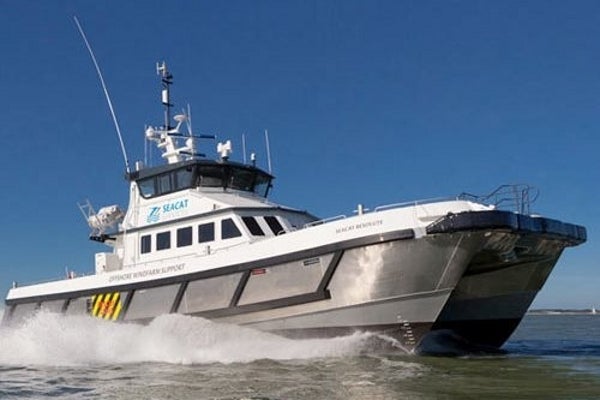
Seacat Ranger is a wind farm service vessel (WFSV) designed and built by British boat builder South Boats IOW, for Seacat Services. The vessel was launched in May and christened at a ceremony held in June.
The vessel is outfitted to transport heavy cargo, along with personnel and technicians, to offshore wind farms across Europe. The boat will be chartered to European offshore wind farm companies for service until May 2015.
The vessel was deployed at Westermost Rough Offshore Wind Farm to complete cable termination under a short-term charter agreement with Nexans Deutschland.
Design details of the Seacat Ranger catamaran vessel
Based on the South Catamaran 24M design, the Seacat Ranger wind farm service vessel is built of marine-grade aluminium. The 78t gross tonnage vessel has an overall length of 25.1m, beam length of 8m and a draft of 1.2m.
The Seacat Ranger offers forward and aft deck spaces of 42m² and 30m² respectively. The vessel’s deck has the capacity to carry 20t of equipment with 15t in the forward and 5t at the aft.
The vessel received Det Norske Veritas (DNV) 1A1 class notations including HSLC R2 Windfarm Service 1 and Category 1, 150 NM from safe haven.
Deck equipment and systems on-board the wind farm service vessel
Seacat Ranger is outfitted with a TMP 900XL Crane, an aluminium anchor winch (AAW)-110 from Hercules Hydraulics and a 186kg super-high holding power (SHHP) anchor with chain and line. The catamaran vessel can be optionally installed with a Palfinger PK6500M knuckle-boom deck crane.
Ancillary facilities on-board the vessel include RG Seasight Rubber bow fenders to protect the hull of the ship, Osbit’s MaXccess crew transfer system and V-GRIP gloves.
The lightweight, highly impact absorbent, cast side vessel fendering was manufactured and supplied by Manuplas.
The vessel is further equipped with a fuel transfer system, pressure washer and crew access system. The deck also features multiple tie-down points, two 10ft container mounts in the forward and another 10ft mount at the aft to secure containers.
On-board storage tanks include a 10,000l fuel tank, a 700l fresh water tank and a 300l black water tank.
Communication and navigation systems on-board the Seacat Services vessel
Communication equipment on-board the Seacat Ranger includes an INMARSAT Sailor RT5000 MF/HF single side band (SSB) radio telephone, a Furuno FA150 Class A automatic identification system (AIS) transceiver, a Furuno SC50 satellite compass, Globesurfer 3G wireless internet, a KVH TracPhone V3 VSAT satellite communication system and Icom F6062 UHF.
The vessel also features a Phontech command intercom system CIS 3100, forward and aft talkback system, port and starboard rescue zone area talkback and passenger saloon talkback supplied by Hailer.
Navigation on-board the Seacat Services is complemented by a Furuno FEA 2107-BB electronic chart display and information system (ECDIS), Furuno MFD-BB Navnet 3D black box processor, a Furuno Navtex NX-700B receiver, a Furuno GP-150 global positioning systems (GPS) navigator, Walker 7070 electromagnetic integrated speed log, two Sailor RT5022 Digital Selective Calling (DSC) of Very High Frequency (VHF) and a Furuno DFF1 digital network sounder.
The vessel is also further complemented by on-board navigation equipment, including a Furuno 2117BB-6.5-24v 12kW high-definition, a 6.5ft open array main radar system and a 12kW Furuno 2117BB-4-24v, 4ft open array radar. The vessel is also fitted with an anemometer, a Furuno DFF1 network sounder, five 19in displays and 12 CCTV cameras.
Accommodation and safety features of the wind farm service vessel
The wind farm service vessel offers accommodation to three crew members and 12 wind farm technicians. The crew are accommodated in two cabins, while passengers are seated on crash tested suspension seats.
Accommodation facilities include a galley / mess area, a bridge mess area, luggage and spares areas, toilet, shower, air-conditioning, heating, cooker, microwave oven, hot water boiler, coffee machine and a fridge.
Additional facilities include an FM Radio, MP3 functionality, three LCD TVs, KVH’s Tracvision mobile satellite TV, a DVD player, wireless 3G internet and high-speed satellite internet (VSAT). The super silent vessel generates noise levels less than 62dba.
The crew transfer vessel also carries life-saving equipment such as three life buoys, 17 life jackets and four eight-man life rafts. The search and rescue equipment includes a Seamarshall SAR Finder, two Jotron SART20 TRON Sart, a Jotron TRON 40GPS/FB5 emergency position-indicating radio beacon (EPIRB), Jotron TRON 45SX EPIRB, three Jotron TRON VHF hand-held radios, and a FLIR thermal imaging camera.
The vessel is further equipped with water rescue equipment, such as a Jason’s Cradle man overboard (MOB) recovery system, SOLAS approved Fibrelight Cradle and ship mounted davit, and an SB sling MOB recovery system.
Fire-fighting equipment includes carbon-dioxide fixed fire-fighting (Fi-Fi) systems in the engine rooms and a hand-operated portable Fi-Fi system for other areas, as well as Consilium’s fire and gas detection systems and a DESMI fire hydraulic salt water pump.
Engine and propulsion South Boats IOW-built Seacat Services vessel
Seacat Ranger is powered by two MTU12V2000 M72 main engines, which generate 2,160kW of power at 2,250 rotations per minute (rpm). The power-plant also includes an ONAN MDKBV generator set, which generates 19.5kW of electric power at 1,500rpm.
The engines, coupled to the two ZF3050 gearboxes, drive two Rolls-Royce 56A3 stainless-steel water jets with a Rolls Royce vector control system (ROCS), enabling the catamaran vessel to sail at a sprint speed of 29k.










